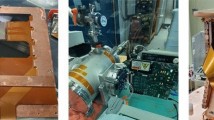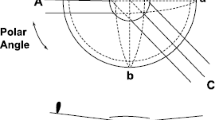Abstract
The AGATA tracking detector array represents a significant improvement over previous Compton suppressed arrays. The construction of AGATA led to numerous technological breakthroughs in order to meet the requirements and the challenges of building a mobile detector across Europe. This paper focuses on the design and implementation of the data acquisition system responsible of the readout and control of the germanium detectors of AGATA. Our system is highly versatile, capable of instrumenting AGATA and seamlessly adapting it to various configurations with a wide range of ancillary detectors and/or spectrometers. It consists of three main components: an autonomous and independent infrastructure, a dedicated application core ensuring overall consistency, and a high-performance software package providing a fully integrated data flow management including the setting-up, the supervision and the slow control of the instrument. In this paper, we present a comprehensive analysis of the system’s design and performance, particularly under high-counting rate conditions.











Similar content being viewed by others
Data availability statement
This manuscript has no associated data or the data will not be deposited. [Authors’ comment: This manuscript describes instrumental developments and access to data as used for the software performance evaluation is available on request.]
Notes
NARVAL stands for Nouvelle Aquisition temps-Reel Version Avec Linux meaning New Aquisition in Real time Version Alongside Linux.
During the Local Level Processing stage, each event occupies 7.6 kBytes. This can be calculated by multiplying the number of channels (38) by the output size per channel (200 Bytes).
Note that when possible, e.g for low multiplicity \(\gamma \)-rays – with AGATA triggered by an ancillary detector resulting in a typical rate of \(\sim \) 100 Hz/crystal, the traces from the FEE can be stored hence contributing to a significant amount of data of \(\sim \) 3 TB/day. However, when dealing with high spin physics that generates high multiplicity \(\gamma \)-rays, this approach becomes impractical or even unattainable.
The replay process allows the users to optimize the post-PSA or tracking or to use new PSA algorithms that are being developed in the collaboration when the traces are stored.
The current management of incoming and outgoing bandwidth involves the implementation of four distinct queues, each with a maximum limit of 300 MB/s. These queues operate in parallel and are dynamically managed to prioritize low latency, particularly during the execution of concurrent large data transfers.
ATCA stands for AGATA Telecommunications Computing Architecture board, which refers to the phase 1 electronic boards that are no longer in use.
References
S. Akkoyun et al., Nucl. Instrum. Methods A 668, 26 (2012). https://doi.org/10.1016/j.nima.2011.11.081
S. Paschalis et al., Nucl. Instrum. Methods A 709, 44 (2013)
A. Korichi, T. Lauritsen, Eur. Phys. J. A 55, 121 (2019). https://doi.org/10.1140/epja/i2019-12787-1
J. Simpson, Z. Phys. A 358, 139 (1997). https://doi.org/10.1007/s002180050290
I.-Y. Lee, Nucl. Phys. A 520, 641c (1990). https://doi.org/10.1016/0375-9474(90)91181-P
R. Janssens, F. Stephens, Nucl. Phys. News Int. 6, 9 (1996). https://doi.org/10.1080/10506899609411095
D.C. Radford, In: Proceedings of the International Seminar on the Frontier of Nuclear Spectroscopy, Kyoto, Japan (World Scientific, 1992), pp. 229–249
G. Knoll, Radiation Detection and Measurement (Wiley, New York, 2010)
I.-Y. Lee, J. Simpson, Nucl. Phys. News 20, 23 (2010). https://doi.org/10.1080/10619127.2010.50612
O. Stézowski et al., Advancements in software developments (Topical Issue ref)
X. Grave, R. Canedo, J.F. Clavelin, S. Du, E. Legay, 14th IEEE-NPSS Real Time Conference, 5 (2005) https://doi.org/10.1109/RTC.2005.1547454
A. Boston et al., AGATA PSA review chapter (Topical Issue ref)
F. Crespi et al., AGATA: performance of \(\gamma \)-ray tracking and associated algorithms (Topical Issue ref)
DCOD, https://forge.in2p3.fr/projects/decode/wiki. Accessed 10 Sept 2021
N. Dosme, X. Grave, E. Legay, “DCOD status”. In: 18th AGATA Week Collaboration Meeting, 2017. https://indico.in2p3.fr/event/14457/contributions/18548/attachments/44342/54945/12.2017-09-15_-_AGATA_week_-_DCOD_status.pdf (2018)
Ada95, “Ada 95 reference manual”, https://www.adahome.com/rm95/ (1995). Accessed 10 Sept 2021
J. Collado et al., AGATA phase 2 advancements on front-end electronics (Topical Issue ref)
J. Ljungvall et al., Nucl. Instrum. Methods Phys. Res. A 955, 163297 (2020). https://doi.org/10.1016/j.nima.2019.163297
D. Ralet et al., Nucl. Instrum. Methods Phys. Res. A 786, 32 (2015). https://doi.org/10.1016/j.nima.2015.03.025
S.M. Sohan, Automated example oriented REST API documentation. https://prism.ucalgary.ca/server/api/core/bitstreams/22b5b95d-bd2c-486f-a44a-ddba9bffb855/content (2017). Accessed 29 May 2021
xml, “Extensible Markup Language (XML) 1.0 (Fifth Edition)”, https://www.w3.org/TR/xml/ (2008). Accessed 10 Sept 2021
E. Clément et al., Nucl. Instrum. Methods A 855, 1 (2017). https://doi.org/10.1016/j.nima.2017.02.063
A. Gadea et al., Nucl. Instrum. Methods A 654, 88 (2011). https://doi.org/10.1016/j.nima.2011.06.004
X. Grave, DAQ overview for AGATA. In: 2nd AGATA–GRETINA Collaboration Meeting. https://indico.in2p3.fr/event/16944/contributions/60393/attachments/47869/60292/grave_greta_agata_april_2018.pdf (2018). Accessed 10 Sept 2021
D. van der Ster, Building scale-out storage infrastructures with RADOS and Ceph. In: CERN, https://indico.in2p3.fr/event/14490/contributions/56328/attachments/44366/54972/vanderster-ceph-XLDB-2017.pdf (2017). Accessed 10 Sept 2021
M. Bellato et al., J. Instrum. 8, P07003 (2013). https://doi.org/10.1088/1748-0221/8/07/P07003
C. Domingo-Pardo et al., Nucl. Instrum. Methods A 694, 297 (2012). https://doi.org/10.1016/j.nima.2011.05.007
J. Valiente-Dobón et al., Nucl. Instrum. Methods A 1049, 168040 (2023). https://doi.org/10.1016/j.nima.2023.168040
F. Recchia, et al., LNL Annual Report 2010. https://www1.lnl.infn.it/~annrep/read_ar/2010/index_contrib.htm (2010)
V. Radeka, Nucl. Instrum. Methods 99, 525 (1972). https://doi.org/10.1016/0029-554X(72)90666-0
N. Lalovic̀ et al., Nucl. Instrum. Methods A 806, 258 (2016). https://doi.org/10.1016/j.nima.2015.10.032
C. Mechelagnoli, EPJ Web Conf. 117, 10004 (2016). https://doi.org/10.1051/epjconf/201611710004
A. Korichi et al., Nucl. Instrum. Methods Phys. Res. A 872, 80 (2017). https://doi.org/10.1016/j.nima.2017.08.020
M. Assié et al., Nucl. Instrum. Methods A 1014, 165743 (2021). https://doi.org/10.1016/j.nima.2021.165743
A. Korichi, E. Clément, High rate capabilities of tracking arrays. In: 2nd AGATA-GRETTINA Collaboration Meeting. https://indico.in2p3.fr/event/16944/contributions/60390/attachments/47901/60348/AGATA-GRETA-April2018-AK.pdf (2018). Accessed 10 Sept 2021
D. Bazzacco, Private communication
M. Rejmund et al., Nucl. Instrum. Methods A 646, 184 (2011). https://doi.org/10.1016/j.nima.2011.05.007
A. Stefanini, et al., Nucl. Phys. A 701, 217 (2002), In: 5th International Conference on Radioactive Nuclear Beams https://doi.org/10.1016/S0375-9474(01)01578-0
J. Valiente-Dobón et al., Nucl. Instrum. Methods A 927, 81 (2019). https://doi.org/10.1016/j.nima.2019.02.021
R. Molina and V. Lafage, PSA: which optimisations? In: 22nd AGATA Week Collaboration Meeting 2022. https://agenda.infn.it/event/30320 (2022). Accessed 10 Sept 2021
R. Molina, “AGATA computation control: from the crystal to the final measure”, AGATA–France collaboration meeting, November (2022), https://indico.ijclab.in2p3.fr/event/8743/contributions/27973/attachments/19952/27360/slides.pdf (2022). Accessed 10 Sept 2021
E. Calore, D. Bazzacco, F. Recchia, Nucl. Inst. and Meth. A 719, 1 (2013). https://doi.org/10.1016/j.nima.2013.04.018
Acknowledgements
We extend our heartfelt appreciation to Dino Bazzacco for his outstanding contribution to AGATA, particularly in the development of the AGATA DAQ-box. His invaluable guidance during the system upgrade, performance measurements, and data acquisition played a vital role in the success of AGATA operations. We also acknowledge the valuable feedback and contributions from the users during the physics campaigns, which helped us make necessary improvements and achieve a robust DAQ-box. Furthermore, we express our gratitude to the AGATA collaboration for their scientific support of this manuscript. This work was made possible by the support of the French National Center of Research, CNRS, France.
Author information
Authors and Affiliations
Corresponding author
Additional information
Communicated by Nicolas Alamanos.
X. Grave: The author is on leave from IJCLab-CNRS
Rights and permissions
Springer Nature or its licensor (e.g. a society or other partner) holds exclusive rights to this article under a publishing agreement with the author(s) or other rightsholder(s); author self-archiving of the accepted manuscript version of this article is solely governed by the terms of such publishing agreement and applicable law.
About this article
Cite this article
Korichi, A., Clément, E., Dosme, N. et al. AGATA DAQ-box: a unified data acquisition system for different experimental conditions. Eur. Phys. J. A 59, 211 (2023). https://doi.org/10.1140/epja/s10050-023-01091-8
Received:
Accepted:
Published:
DOI: https://doi.org/10.1140/epja/s10050-023-01091-8




